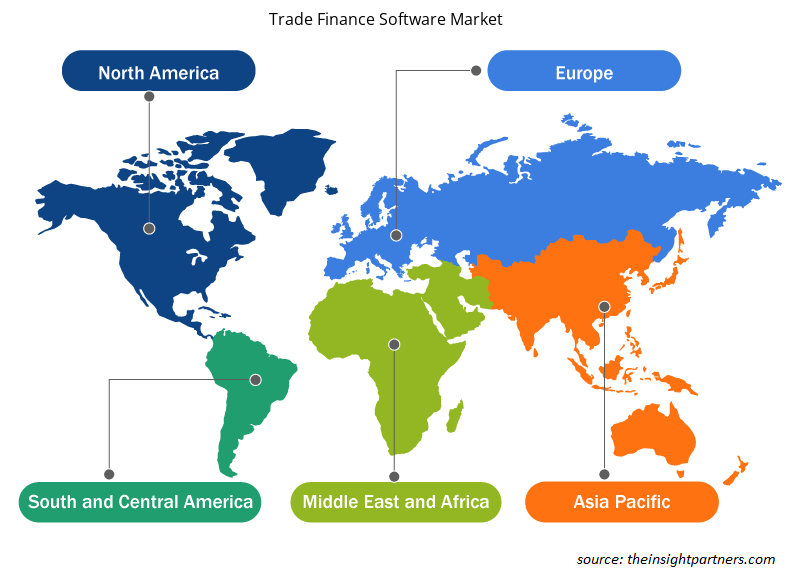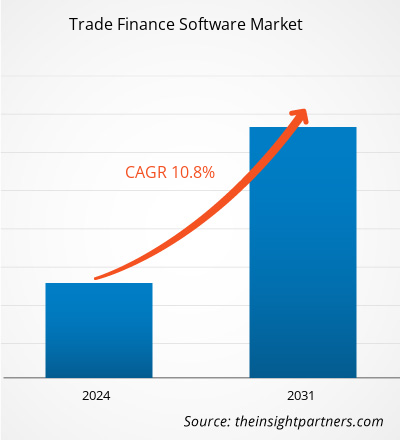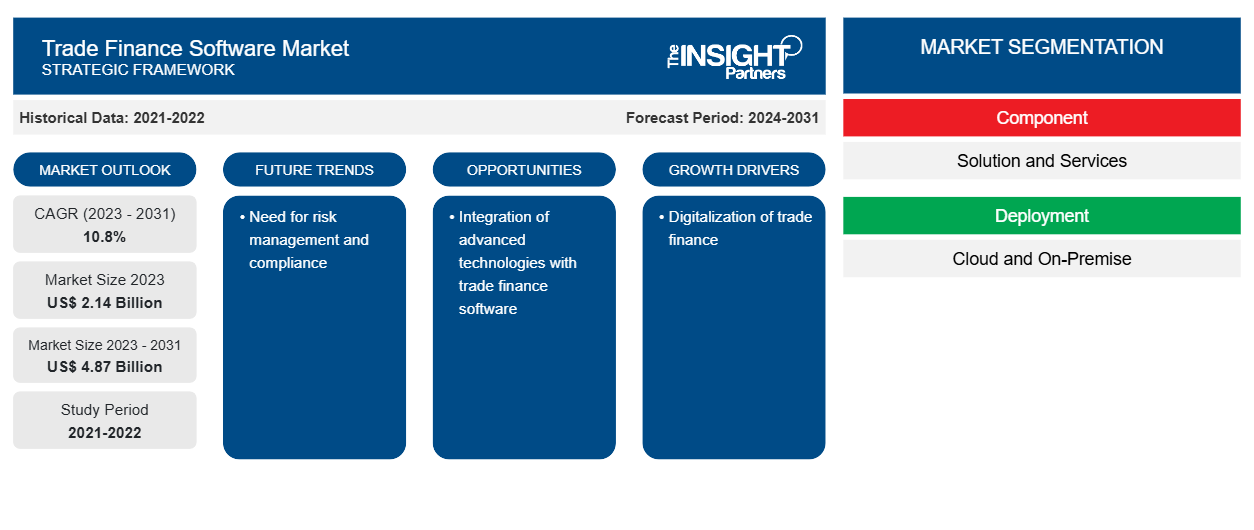Der Markt für Handelsfinanzierungssoftware soll von 2,14 Milliarden US-Dollar im Jahr 2023 auf 4,87 Milliarden US-Dollar im Jahr 2031 anwachsen. Der Markt soll zwischen 2023 und 2031 eine durchschnittliche jährliche Wachstumsrate (CAGR) von 10,8 % verzeichnen. Die zunehmende Digitalisierung und die Einführung cloudbasierter Technologien dürften weiterhin die wichtigsten Trends auf dem Markt für Handelsfinanzierungssoftware bleiben.
Marktanalyse für Handelsfinanzierungssoftware
Die zunehmende Digitalisierung von Handelsfinanzierungsprozessen ist ein wichtiger Faktor, der das Wachstum des Marktes für Handelsfinanzierungssoftware ankurbelt. Mit erhöhter Effizienz und niedrigeren Kosten ersetzen elektronische Dokumentation und Cloud-basierte Handelsfinanzierungslösungen zunehmend traditionelle papierbasierte Methoden und tragen zum Marktwachstum bei.
Marktübersicht für Handelsfinanzierungssoftware
Das Bedürfnis nach Transparenz und Einhaltung internationaler Handelsvorschriften hat zur Einführung von Softwarelösungen mit Echtzeitüberwachungs- und Berichtsfunktionen geführt. Mit dem Schwerpunkt auf der Bereitstellung hochmoderner Lösungen, die den sich ändernden Anforderungen des internationalen Handels gerecht werden, ist der Markt für Handelsfinanzierungssoftware bereit für eine weitere Expansion, da sich die globale Handelslandschaft weiter verändert und Unternehmen nach sichereren und effizienteren Handelsfinanzierungsgeschäften suchen.
Passen Sie diesen Bericht Ihren Anforderungen an
Sie erhalten kostenlose Anpassungen an jedem Bericht, einschließlich Teilen dieses Berichts oder einer Analyse auf Länderebene, eines Excel-Datenpakets sowie tolle Angebote und Rabatte für Start-ups und Universitäten.
-
Holen Sie sich die wichtigsten Markttrends aus diesem Bericht.Dieses KOSTENLOSE Beispiel umfasst eine Datenanalyse von Markttrends bis hin zu Schätzungen und Prognosen.
Treiber und Chancen auf dem Markt für Handelsfinanzierungssoftware
Digitalisierung der Handelsfinanzierung begünstigt den Markt
Da Unternehmen aus einer Vielzahl von Branchen erkennen, dass sie hochmoderne Lösungen benötigen, um ihre internationalen Handelsgeschäfte zu beschleunigen und zu verbessern, wächst der Markt erheblich. Dieser Markt umfasst Softwareprogramme zur Verbesserung und Automatisierung von Handelsfinanzierungsverfahren , wie z. B. Lieferkettenfinanzierung, Compliance-Management, Rechnungsfactoring und Kreditmanagement. Unternehmen haben sich Handelsfinanzierungssoftware zugewandt, um manuelle und zeitaufwändige Aufgaben zu reduzieren, die Genauigkeit zu verbessern und die mit dem internationalen Handel verbundenen Risiken aufgrund der zunehmenden Komplexität und des Volumens von Handelstransaktionen zu minimieren, was weiter dazu führt, dass Handelsfinanzierungssoftware von Marktteilnehmern übernommen wird. So gab beispielsweise im November 2023 Finastra, ein globaler Anbieter von Finanzsoftwareanwendungen und -märkten, bekannt, dass die CQUR Bank, eine internationale Firmenbank, eine Partnerschaft mit Finastra eingegangen ist, um ihre Technologiestrategie umzusetzen. Mit der Implementierung der marktführenden Lösungen Trade Innovation und Corporate Channels von Finastra bietet die CQUR Bank ihren Firmenkunden ein neues Online-Banking-Portal für ein nahtloses Benutzererlebnis, führt neue digitale Arbeitsabläufe ein und bietet Host-to-Host-Integrationslösungen.
Notwendigkeit von Risikomanagement und Compliance
Der wachsende Bedarf an verbessertem Risikomanagement und Compliance ist ein weiterer Faktor, der das Wachstum des Marktes für Handelsfinanzierungssoftware vorantreibt. Handelsfinanzierungssoftware bietet ausgefeilte Tools wie Betrugserkennung, Anti-Geldwäsche -Prüfungen (AML) und Einhaltung von Handelsgesetzen und Sanktionen zur Verfolgung und Reduzierung von Risiken im Zusammenhang mit dem internationalen Handel. Der Bedarf an diesen Softwarelösungen wächst ständig, da Unternehmen und Finanzinstitute versuchen, die Herausforderungen des internationalen Handels zu bewältigen und gleichzeitig die Einhaltung gesetzlicher und regulatorischer Vorschriften aufrechtzuerhalten.
Segmentierungsanalyse des Marktberichts für Handelsfinanzierungssoftware
Wichtige Segmente, die zur Ableitung der Marktanalyse für Handelsfinanzierungssoftware beigetragen haben, sind Komponente, Bereitstellung, Unternehmensgröße und Endverwendung.
- Basierend auf der Komponente ist der Markt in Lösungen und Dienste segmentiert. Das Lösungssegment hatte im Jahr 2023 einen größeren Marktanteil.
- Nach Bereitstellung ist der Markt in Cloud und On-Premise segmentiert. Das Cloud-Segment hatte im Jahr 2023 einen größeren Marktanteil.
- Nach Unternehmensgröße ist der Markt in Großunternehmen und KMU segmentiert. Das KMU-Segment dürfte die höchste durchschnittliche jährliche Wachstumsrate aufweisen.
- Nach Endverbrauch ist der Markt in Banken, Händler und andere segmentiert. Das Bankensegment hatte im Jahr 2023 einen größeren Marktanteil.
Marktanteilsanalyse für Handelsfinanzierungssoftware nach geografischer Lage
Der geografische Umfang des Marktberichts für Handelsfinanzierungssoftware ist hauptsächlich in fünf Regionen unterteilt: Nordamerika, Asien-Pazifik, Europa, Naher Osten und Afrika sowie Südamerika/Süd- und Mittelamerika.
In Bezug auf den Umsatz hatte Nordamerika im Jahr 2023 den größten Marktanteil an Handelsfinanzierungssoftware. Nordamerika ist ein früher Anwender technologischer Lösungen, was zu einem rasanten Marktanteilswachstum führt. Die Einführung cloudbasierter Technologien durch KMU führt zu Marktwachstum. Die rasant zunehmende Digitalisierung in den Banken erfordert zusätzlich Handelsfinanzierungssoftware, was den Marktanteil der nordamerikanischen Handelsfinanzierung steigert.
Regionale Einblicke in den Markt für Handelsfinanzierungssoftware
Die regionalen Trends und Faktoren, die den Markt für Handelsfinanzierungssoftware während des Prognosezeitraums beeinflussen, wurden von den Analysten von Insight Partners ausführlich erläutert. In diesem Abschnitt werden auch die Marktsegmente und die Geografie von Handelsfinanzierungssoftware in Nordamerika, Europa, im asiatisch-pazifischen Raum, im Nahen Osten und Afrika sowie in Süd- und Mittelamerika erörtert.

- Erhalten Sie regionale Daten zum Markt für Handelsfinanzierungssoftware
Umfang des Marktberichts zur Handelsfinanzierungssoftware
| Berichtsattribut | Details |
|---|---|
| Marktgröße im Jahr 2023 | 2,14 Milliarden US-Dollar |
| Marktgröße bis 2031 | 4,87 Milliarden US-Dollar |
| Globale CAGR (2023 - 2031) | 10,8 % |
| Historische Daten | 2021-2022 |
| Prognosezeitraum | 2024–2031 |
| Abgedeckte Segmente |
Nach Komponente
|
| Abgedeckte Regionen und Länder |
Nordamerika
|
| Marktführer und wichtige Unternehmensprofile |
|
Dichte der Marktteilnehmer für Handelsfinanzierungssoftware: Die Auswirkungen auf die Geschäftsdynamik verstehen
Der Markt für Handelsfinanzierungssoftware wächst rasant, angetrieben durch die steigende Nachfrage der Endnutzer aufgrund von Faktoren wie sich entwickelnden Verbraucherpräferenzen, technologischen Fortschritten und einem größeren Bewusstsein für die Vorteile des Produkts. Mit steigender Nachfrage erweitern Unternehmen ihr Angebot, entwickeln Innovationen, um die Bedürfnisse der Verbraucher zu erfüllen, und nutzen neue Trends, was das Marktwachstum weiter ankurbelt.
Die Marktteilnehmerdichte bezieht sich auf die Verteilung der Firmen oder Unternehmen, die in einem bestimmten Markt oder einer bestimmten Branche tätig sind. Sie gibt an, wie viele Wettbewerber (Marktteilnehmer) in einem bestimmten Marktraum im Verhältnis zu seiner Größe oder seinem gesamten Marktwert präsent sind.
Die wichtigsten auf dem Markt für Handelsfinanzierungssoftware tätigen Unternehmen sind:
- CGI Inc
- Comarch SA
- IBSFINtech
- ICS FINANCIAL SYSTEMS LTD
- MITech - Machen Sie Intuitive Tech SA
- Newgen Software Technologies Ltd.
Haftungsausschluss : Die oben aufgeführten Unternehmen sind nicht in einer bestimmten Reihenfolge aufgeführt.

- Überblick über die wichtigsten Akteure auf dem Markt für Handelsfinanzierungssoftware
Nachrichten und aktuelle Entwicklungen zum Markt für Handelsfinanzierungssoftware
Der Markt für Handelsfinanzierungssoftware wird durch die Erfassung qualitativer und quantitativer Daten nach Primär- und Sekundärforschung bewertet, die wichtige Unternehmensveröffentlichungen, Verbandsdaten und Datenbanken umfasst. Im Folgenden finden Sie eine Liste der Entwicklungen auf dem Markt:
- Im September 2022 stellte Newgen Software, ein weltweit führender Anbieter von Produkten zur digitalen Transformation, auf dem Kundentreffen in Mumbai die weltweit erste Low-Code-Handelsfinanzierungsplattform vor. Handelsfinanzierung ist ein komplexer Prozess, da er viel Papierkram, mehrere Interessengruppen und Compliance-Anforderungen umfasst. Die umfassende, konfigurierbare und zukunftssichere Handelsfinanzierungsplattform von Newgen hilft Banken, papierlos zu werden und ihre End-to-End-Handelsprozesse zu optimieren und gleichzeitig die Einhaltung nationaler und internationaler Vorschriften sicherzustellen. (Quelle: CXOtoday, Pressemitteilung, 2022)
- Im Februar 2024 kündigten Finastra, ein globaler Anbieter von Finanzsoftwareanwendungen und -marktplätzen, und Tesselate, ein globales Beratungs- und Integrationsunternehmen für digitale Transformation, die Einführung eines End-to-End-Fertigpaketdienstes für eine schnellere und einfachere Digitalisierung der Handelsfinanzierung an. Tegula Trade Finance as a Service, unterstützt von Finastra Trade Innovation und Corporate Channels, ermöglicht es US-Banken, manuelle Prozesse zu automatisieren und sich mit einer schnelleren Markteinführung und Wertschöpfung an neue Anforderungen anzupassen. Über Finastras FusionFabric.cloud können Banken außerdem nahtlos Fintech-Anwendungen integrieren, die die neuesten Technologien wie künstliche Intelligenz, Blockchain und Automatisierungstools nutzen. (Quelle: Finastra, Pressemitteilung, 2024)
Marktbericht zu Handelsfinanzierungssoftware – Abdeckung und Ergebnisse
Der Bericht „Marktgröße und Prognose für Handelsfinanzierungssoftware (2021–2031)“ bietet eine detaillierte Analyse des Marktes, die die folgenden Bereiche abdeckt:
- Marktgröße und Prognose auf globaler, regionaler und Länderebene für alle wichtigen Marktsegmente, die im Rahmen des Projekts abgedeckt sind
- Marktdynamik wie Treiber, Beschränkungen und wichtige Chancen
- Wichtige Zukunftstrends
- Detaillierte PEST/Porters Five Forces- und SWOT-Analyse
- Globale und regionale Marktanalyse mit wichtigen Markttrends, wichtigen Akteuren, Vorschriften und aktuellen Marktentwicklungen
- Branchenlandschaft und Wettbewerbsanalyse, einschließlich Marktkonzentration, Heatmap-Analyse, prominenten Akteuren und aktuellen Entwicklungen
- Detaillierte Firmenprofile
- Historische Analyse (2 Jahre), Basisjahr, Prognose (7 Jahre) mit CAGR
- PEST- und SWOT-Analyse
- Marktgröße Wert/Volumen – Global, Regional, Land
- Branchen- und Wettbewerbslandschaft
- Excel-Datensatz
Aktuelle Berichte
Verwandte Berichte
Erfahrungsberichte
Grund zum Kauf
- Fundierte Entscheidungsfindung
- Marktdynamik verstehen
- Wettbewerbsanalyse
- Kundeneinblicke
- Marktprognosen
- Risikominimierung
- Strategische Planung
- Investitionsbegründung
- Identifizierung neuer Märkte
- Verbesserung von Marketingstrategien
- Steigerung der Betriebseffizienz
- Anpassung an regulatorische Trends























 Kostenlose Probe anfordern für - Markt für Handelsfinanzierungssoftware
Kostenlose Probe anfordern für - Markt für Handelsfinanzierungssoftware